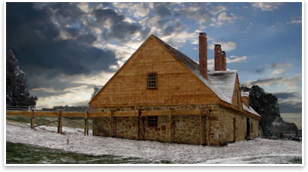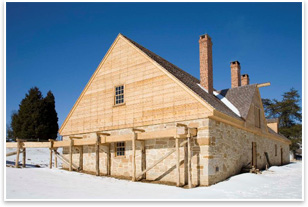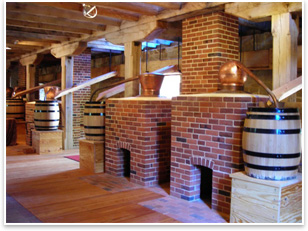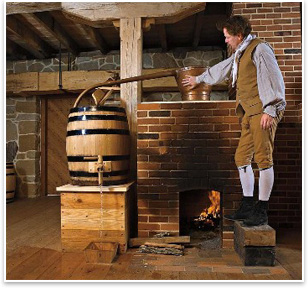A Toast to George Washington’s Distillery
Reconstruction honored by AIA Virginia, AIA Northern Virginia
by Russell Boniface
Associate Editor
 How do you . . . authentically recreate a Colonial-era structure using design, construction, and materials of that time period? How do you . . . authentically recreate a Colonial-era structure using design, construction, and materials of that time period?
Summary: George Washington's Distillery at Mount Vernon, Va., which opened in March, recently was honored for architectural excellence and historic preservation by AIA Virginia, AIA Northern Virginia, and Wood Design & Building magazine. George Washington’s Distillery is a $3 million reconstruction of Washington's original, 2,250-square-foot distillery, which was erected in 1797 two miles from his Mount Vernon, Va., estate that overlooks the Potomac River. The restoration team at Historic Mount Vernon, led by Washington, D.C.-based Quinn Evans Architects, used 18th-century distillery design and construction techniques and Colonial era wood and other materials to authentically reconstruct the distillery.
 In 1799, Washington produced 11,000 gallons of whiskey in the post-and-beam structure. The reconstructed distillery sits on a 21-acre site near Historic Mount Vernon and demonstrates Washington’s distilling process to visitors to the estate. Historic Mount Vernon, owned and maintained by the Mount Vernon Ladies' Association, researched, excavated, and restored the distillery for $3 million, in part with a $2 million grant from the Distilled Spirits Council of the U.S. The project, started in 2001, used hand-crafted building techniques from 200 years ago. In 1799, Washington produced 11,000 gallons of whiskey in the post-and-beam structure. The reconstructed distillery sits on a 21-acre site near Historic Mount Vernon and demonstrates Washington’s distilling process to visitors to the estate. Historic Mount Vernon, owned and maintained by the Mount Vernon Ladies' Association, researched, excavated, and restored the distillery for $3 million, in part with a $2 million grant from the Distilled Spirits Council of the U.S. The project, started in 2001, used hand-crafted building techniques from 200 years ago.
Reconstructing a working distillery
“We are very proud of our awards,” says Dennis Pogue, Historic Mount Vernon’s chief historian and director of preservation. Pogue worked with architects, carpenters, and archaeologists to recreate Washington’s two-story distillery, which sits adjacent to a reconstruction of Washington’s stone gristmill that he originally used to produce flour and cornmeal. “We did archaeology for five years and found the footprint of the building and where the stills were located. We combined that with the documentary records and were able to accurately reconstruct the building.”
 To make the distillery authentic, the team used 18th-century materials, distillery design, and construction techniques. For example, Colonial-era timber, mortar joints, sandstone blocks, copper stills, and mash tubs were incorporated. “We made the building look as much like the building that Washington would recognize, given the constraints placed on us by building in the 21st century,” says Pogue. “We met modern design and code issues with unobtrusive compromises. For example, the staircase is bigger and better built to meet fire requirements.” To make the distillery authentic, the team used 18th-century materials, distillery design, and construction techniques. For example, Colonial-era timber, mortar joints, sandstone blocks, copper stills, and mash tubs were incorporated. “We made the building look as much like the building that Washington would recognize, given the constraints placed on us by building in the 21st century,” says Pogue. “We met modern design and code issues with unobtrusive compromises. For example, the staircase is bigger and better built to meet fire requirements.”
The distillery will work with the gristmill. “We don’t normally produce whiskey,” Pogue explains. “We demonstrate by distilling water because the process is the same.”
Two AIA awards; one magazine award
VSAIA awarded the distillery its 2007 “Award for Excellence in Historic Preservation” for excellence in preservation design, documentation and research, archaeology, and reconstruction techniques. Says Pogue: “Reconstructions are controversial, but they felt it was important to reward a project that went above and beyond in research and preparation for authenticity.”
 The AIA Northern Virginia Chapter recognized the distillery with its “Craftsman Award.” The distillery received this award over new construction projects in the region, and it was the first time in five years the award was given. Notes Pogue: “It was a wide net competing against new construction in Northern Virginia, so it’s prestigious.” The AIA Northern Virginia Chapter recognized the distillery with its “Craftsman Award.” The distillery received this award over new construction projects in the region, and it was the first time in five years the award was given. Notes Pogue: “It was a wide net competing against new construction in Northern Virginia, so it’s prestigious.”
Wood Design & Building magazine honored the distillery as a Merit Award winner in its 2007 Wood Design Awards, the only North American program that recognizes achievements in wood architecture. Almost one dozen wood species were incorporated into the distillery “This award focused on the carpentry and the woods that made it look appropriate to the period,” Pogue points out.
Washington the distiller
Pogue says the reconstruction was an opportunity to cast a light on a part of Washington’s career that most people don’t know about. “At the end of his second term as president, Washington hired a Scotsman named James Anderson to be his plantation manager. Anderson had experience distilling and immediately lobbied Washington that it could make money. Washington was interested but skeptical. He wrote friends for advice and was told it was a good market.”
 Distilling whiskey became lucrative for Washington. “In 1797, Washington and Anderson bought stills and set them up in an existing building,” Pogue mentions. “By the end of the year, they made several hundred gallons of whiskey, and it sold readily. Washington agreed to Anderson’s plan to build a new distillery dedicated to the process. They bought three more stills, and by March of 1798 the building was complete.” By 1799, Washington produced 11,000 gallons of whiskey worth $7,500. After Washington's death, the distillery went into disrepair and ultimately burned down in 1814. Distilling whiskey became lucrative for Washington. “In 1797, Washington and Anderson bought stills and set them up in an existing building,” Pogue mentions. “By the end of the year, they made several hundred gallons of whiskey, and it sold readily. Washington agreed to Anderson’s plan to build a new distillery dedicated to the process. They bought three more stills, and by March of 1798 the building was complete.” By 1799, Washington produced 11,000 gallons of whiskey worth $7,500. After Washington's death, the distillery went into disrepair and ultimately burned down in 1814.
What visitors will see
Colonial-dressed guides demonstrate the 18th-century distilling process using five copper stills, each above a fireplace, and mash tubs. On the second floor there is an exhibit about alcohol in America, Spirits of Independence: George Washington and the Beginnings of the American Whiskey Industry, and an eight-minute History Channel video, George Washington's Liquid Gold.
By the end of this summer, Pogue adds, the building will distill actual 18th-century whiskey. “Small bottles of whiskey for those interested in what Washington’s whiskey tasted like.” |


 How do you . . .
How do you . . . 


